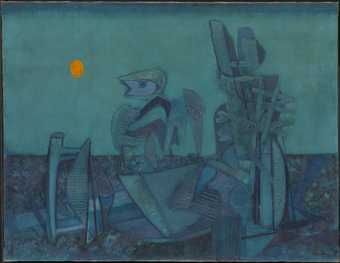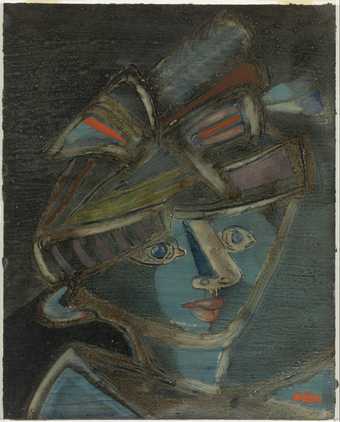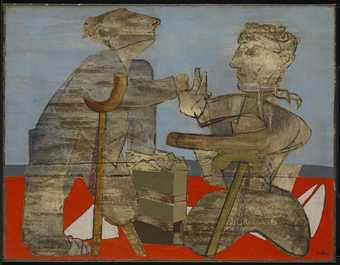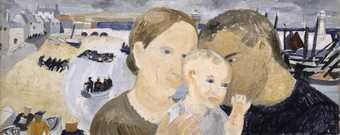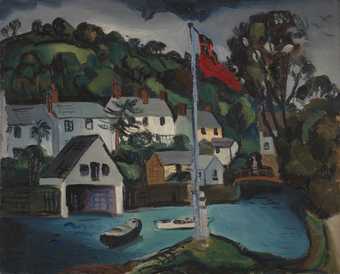
Not on display
- Artist
- Jankel Adler 1895–1949
- Medium
- Oil paint and gesso on paper on plywood
- Dimensions
- Support: 573 × 788 mm
frame: 814 × 1024 × 60 mm - Collection
- Tate
- Acquisition
- Accepted by HM Government in Lieu of Inheritance Tax from the estate of Eleonore Marie Herman and allocated to Tate 2017
- Reference
- T14910
Summary
Orphans 1942 depicts two figures imprisoned behind a horizontal bar. Clutching a few belongings, their eyes are wide with sorrow and despair. Executed in a sombre palette of purples, greens and blues, the work shows Adler and his close friend and fellow emigré artist, Josef Herman (1911–2000) as the grieving orphans of the title, distraught at the loss of their families. Both artists had lost their entire family at the hands of the Nazis during the Holocaust, with Adler losing all nine of his siblings. Adler had worked with Paul Klee (1879–1940) in Düsseldorf, Germany in the early 1930s, before he was declared a ‘degenerate’ artist by the Nazis in 1933 and left for Paris, finally moving to Britain in 1941, while Herman had fled Poland for Brussels and Paris, arriving in Britain in 1940. Orphans shows the influence of Klee and the late cubism of Pablo Picasso (1881¿–1973) in its interlocking forms held together by strong black outlines. As in many of Adler’s paintings of this period there is a subtle interplay between formal simplification and the communication of emotional states.
Adler and Herman – both Polish and Yiddish-speaking – had known each other in Warsaw before the war and, once settled in Britain, became the closest of companions. In 1942 Herman suffered a serious breakdown following the news of his family’s extermination and Adler nursed him through his illness. Nini Herman, Josef’s second wife, wrote of Orphans in 1996:
Was it perhaps, to heal them both (who often spoke of themselves as a ‘conspiracy of two’), that [Jankel] set to work on a painting. Sombre in charcoal greys, dark green and violent, two figures loom behind a horizontal bar, as if imprisoned by despair, a total anguish in their eyes. The painting which he called The Orphans hangs over our mantlepiece.
(Herman 1996, p.61.)
Adler gifted the work to Herman, who kept it all his life, and it remains a powerful statement of the bond between émigré artists in Britain in the 1940s, and their struggles to process their experiences of persecution and death. Orphans is one of four paintings by Adler from the early 1940s in Tate’s collection. The Mutilated 1942–3 (Tate T00372) offers another representation of the impact of the Second World War on émigré artists.
Further reading
Jankel Adler, exhibition catalogue, Stadtische Kunsthalle Dusseldorf 1985, no.89.
Nini Herman, Josef Herman: A Working Life, London 1996, pp.61, 65.
Douglas Hall, Art in Exile: Polish Painters in Post-War Britain, Bristol 2008, p.309.
Emma Chambers
April 2016
Does this text contain inaccurate information or language that you feel we should improve or change? We would like to hear from you.
Explore
- abstraction(8,615)
-
- from recognisable sources(3,634)
-
- figure(2,270)
- emotions and human qualities(5,345)
- military: World War II(1,269)
-
- Holocaust(39)
- Jewish(3,752)
- Adler, Jankel(6)
- Herman, Josef(1)
- refugee(1,995)
You might like
-
Jankel Adler No Man’s Land
1943 -
Jankel Adler Woman with Hat
1940 -
Jankel Adler The Mutilated
1942–3 -
Christopher Wood The Fisherman’s Farewell
1928 -
Christopher Wood Untitled (Helford)
c.1926

